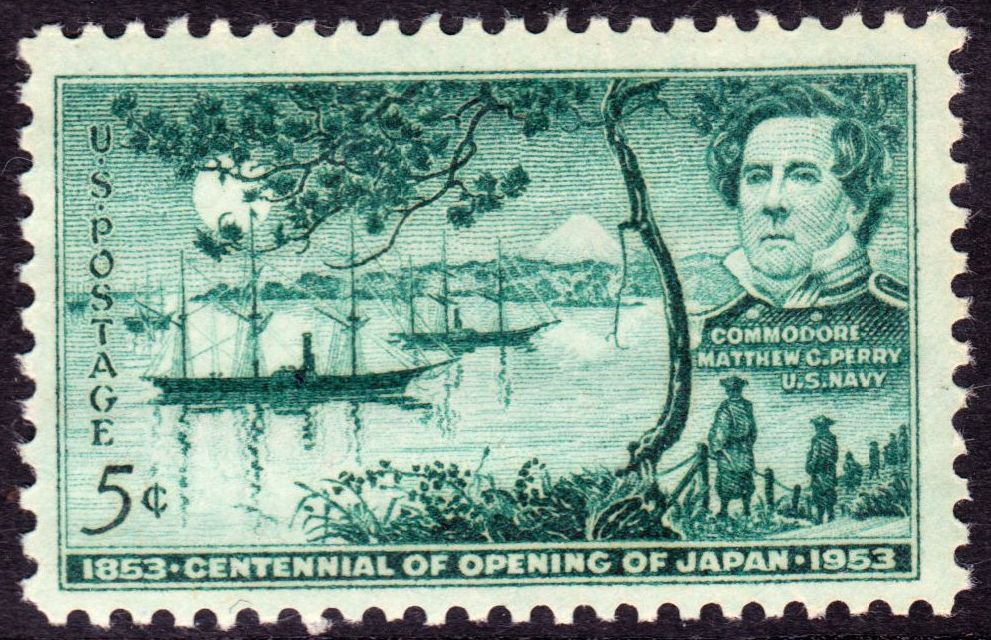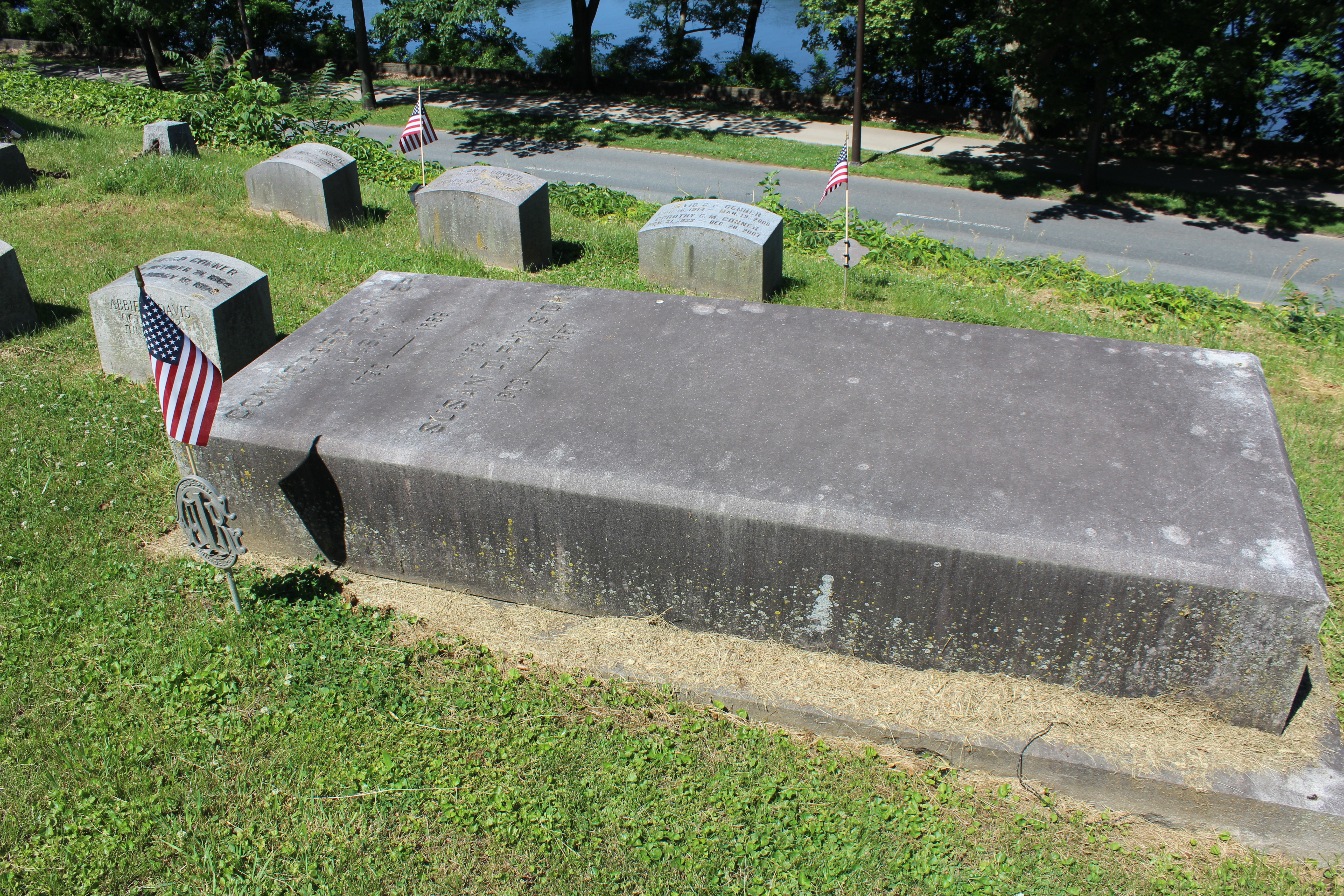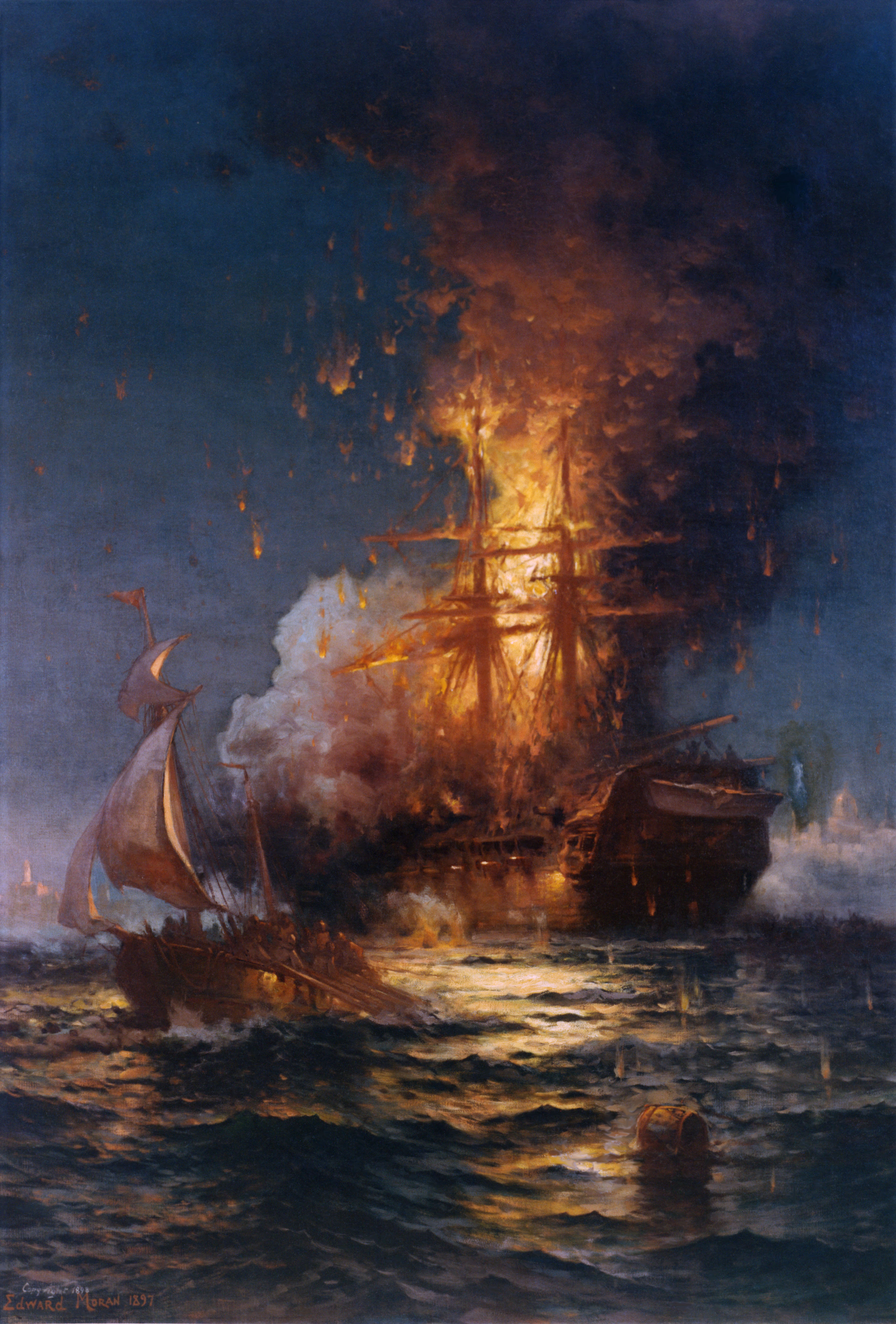|
Edmund Colhoun
Edmund Ross Colhoun (6 May 1821 – 17 February 1897) was a rear admiral of the United States Navy who served during the Mexican War and the American Civil War, in which he was commended for his participation in the bombardment and capture of Fort Fisher. Naval career Service from 1839 to 1853 Colhoun was born at Chambersburg, Pennsylvania, on 6 May 1821 and was appointed a midshipman on 1 April 1839. He was attached to the sloop-of-war in the Brazil Squadron from 1839 to 1841, then to the frigate in the Mediterranean Squadron and Brazil Squadron from 1842 to 1844. He then attended the Philadelphia Naval School in Philadelphia, Pennsylvania, in 1845 and, after completing his studies, was promoted to passed midshipman on 2 July 1845. Colhoun next served aboard the frigate from 1846 to 1847, seeing action in the Mexican War, first under Commodore David Conner in the first attack on Alvarado, Mexico, and then under Commodore Matthew C. Perry at Tabasco, Mexico. From 1850 ... [...More Info...] [...Related Items...] OR: [Wikipedia] [Google] [Baidu] |
Arlington National Cemetery
Arlington National Cemetery is one of two national cemeteries run by the United States Army. Nearly 400,000 people are buried in its 639 acres (259 ha) in Arlington, Virginia. There are about 30 funerals conducted on weekdays and 7 held on Saturday. The other Army cemetery is in Washington, D.C. and is called the U.S. Soldiers' and Airmen's Home National Cemetery. All other national cemeteries are run by the National Cemetery System of the Department of Veterans Affairs. Arlington National Cemetery was established during the U.S. Civil War after the land the cemetery was built upon, Arlington Estate, was confiscated from private ownership following a tax dispute. Listed on the National Register of Historic Places in April 2014, the Arlington National Cemetery Historic District includes the Cemetery, Arlington House, Memorial Drive, the Hemicycle, and Arlington Memorial Bridge. History George Washington Parke Custis was the grandson of Martha Dandridge Custis Washington th ... [...More Info...] [...Related Items...] OR: [Wikipedia] [Google] [Baidu] |
Fort Fisher
Fort Fisher was a Confederate fort during the American Civil War. It protected the vital trading routes of the port at Wilmington, North Carolina, from 1861 until its capture by the Union in 1865. The fort was located on one of Cape Fear River's two outlets to the Atlantic Ocean on what was then known as Federal Point or Confederate Point and today is known as Pleasure Island. The strength of Fort Fisher led to its being called the ''Southern Gibraltar'' and the "Malakoff Tower of the South". The battle of Fort Fisher was the most decisive battle of the Civil War fought in North Carolina. Significance Wilmington The city of Wilmington is located upstream from the mouth of the Cape Fear River, which flows into the Atlantic Ocean. During the war, Wilmington was one of the most important points of entry for supplies for the Confederacy. Its port traded cotton and tobacco in exchange for foreign goods, like munitions, clothing and foodstuffs. This nourished both the southern ... [...More Info...] [...Related Items...] OR: [Wikipedia] [Google] [Baidu] |
Matthew Perry (naval Officer)
Matthew Calbraith Perry (April 10, 1794 – March 4, 1858) was a commodore of the United States Navy who commanded ships in several wars, including the War of 1812 and the Mexican–American War (1846–1848). He played a leading role in the opening of Japan to the West with the Convention of Kanagawa in 1854. Perry was interested in the education of naval officers and assisted in the development of an apprentice system that helped establish the curriculum at the United States Naval Academy. With the advent of the steam engine, he became a leading advocate of modernizing the U.S. Navy and came to be considered "The Father of the Steam Navy" in the United States. Lineage Matthew Perry was a member of the Perry family, a son of Sarah Wallace ( née Alexander) (1768–1830) and Navy Captain Christopher Raymond Perry (1761–1818). He was born April 10, 1794, South Kingstown, Rhode Island. His siblings included Oliver Hazard Perry, Raymond Henry Jones Perry, Sarah Wallace Perry, A ... [...More Info...] [...Related Items...] OR: [Wikipedia] [Google] [Baidu] |
Mexico
Mexico (Spanish: México), officially the United Mexican States, is a country in the southern portion of North America. It is bordered to the north by the United States; to the south and west by the Pacific Ocean; to the southeast by Guatemala, Belize, and the Caribbean Sea; and to the east by the Gulf of Mexico. Mexico covers ,Mexico ''''. . making it the world's 13th-largest country by are ... [...More Info...] [...Related Items...] OR: [Wikipedia] [Google] [Baidu] |
Alvarado, Veracruz
, timezone_link = Time in Mexico , timezone = CST , utc_offset = -6 , timezone_DST = CDT , utc_offset_DST = -5 , coordinates = , elevation_footnotes = , elevation_m = 10 , elevation_ft = , postal_code_type = Postal code , postal_code = 95250, 95270, 95272, 95274 to 95278 , area_code = 297 , blank_name = HDI (2002) , blank_info = 0.77987 () , blank2_name = Climate , blank2_info = Aw , website alvarado.gob.mx, footnotes = ''Alvarado'' (officially: ''Ilustre, Heroica y Generosa Ciudad y Puerto de Alvarado'') is a city in the Mexican state of Veracruz. The city also serves as the municipal seat for the surrounding municipali ... [...More Info...] [...Related Items...] OR: [Wikipedia] [Google] [Baidu] |
David Conner (naval Officer)
Commodore David Conner (1792 – 20 March 1856) was an officer of the United States Navy. He served in the War of 1812 and led the Home Squadron during the Mexican–American War. He led the successful naval assault during the siege of Veracruz which included the landing of 10,000 U.S. troops, the largest U.S. military amphibious assault at the time. He served on the Board of Navy Commissioners; as the first Chief of the Bureau of Construction, Equipment, and Repair; as a Special Diplomatic Agent to Mexico and commanded the Philadelphia Naval Yard. Early life Conner was born in Harrisburg, Pennsylvania. He was the son of David Conner, an Irishman and Abigail Rhodes, who was of English descent. He worked in Philadelphia and then joined the U.S. Navy on 16 January 1809. He served his first few years as a midshipman on the frigate . Military career During the War of 1812 Conner served in during her chase of HMS ''Belvidera'' and her actions with in February 1813 and the March ... [...More Info...] [...Related Items...] OR: [Wikipedia] [Google] [Baidu] |
Commodore (United States)
Commodore was an early title and later a rank in the United States Navy, United States Coast Guard and the Confederate States Navy, and also has been a rank in the United States Public Health Service Commissioned Corps and the National Oceanic and Atmospheric Administration Commissioned Officer Corps (NOAA Corps) and its ancestor organizations. For over two centuries, the designation has been given varying levels of authority and formality. Today, it is no longer a specific rank within active-duty or reserve forces or in the Public Health Service Commissioned Corps or NOAA Corps, but it remains in use as an ''honorary title'' within the U.S. Navy and U.S. Coast Guard for those senior captains (pay grade O-6) in command of operational organizations composed of multiple independent subordinate naval units (e.g., multiple independent ships or aviation squadrons). However, "commodore" is a rank that is actively used to this day in the United States Coast Guard Auxiliary, the civ ... [...More Info...] [...Related Items...] OR: [Wikipedia] [Google] [Baidu] |
Passed Midshipman
A passed midshipman, sometimes called as "midshipman, passed", is a term used historically in the 19th century to describe a midshipman who had passed the lieutenant's exam and was eligible for promotion to lieutenant as soon as there was a vacancy in that grade. Royal Navy Passed midshipman was never an official rank or rating in the Royal Navy, but was commonly used to describe midshipmen who had passed the lieutenant examination but were waiting on a roster to be commissioned. Between 1800 and 1815, due to a shortage of officers to command small craft, passed midshipmen were titled sub-lieutenant but this also was not an official rank. Passed midshipmen awaiting promotion often elected to become master's mate, an experienced seaman role as assistant to the master. Though formally the rating did not lead to promotion to lieutenant, master's mates were paid more than any other rating and were the only ratings allowed to command any sort of vessel. A midshipman who became mast ... [...More Info...] [...Related Items...] OR: [Wikipedia] [Google] [Baidu] |
Philadelphia, Pennsylvania
Philadelphia, often called Philly, is the largest city in the Commonwealth of Pennsylvania, the sixth-largest city in the U.S., the second-largest city in both the Northeast megalopolis and Mid-Atlantic regions after New York City. Since 1854, the city has been coextensive with Philadelphia County, the most populous county in Pennsylvania and the urban core of the Delaware Valley, the nation's seventh-largest and one of world's largest metropolitan regions, with 6.245 million residents . The city's population at the 2020 census was 1,603,797, and over 56 million people live within of Philadelphia. Philadelphia was founded in 1682 by William Penn, an English Quaker. The city served as capital of the Pennsylvania Colony during the British colonial era and went on to play a historic and vital role as the central meeting place for the nation's founding fathers whose plans and actions in Philadelphia ultimately inspired the American Revolution and the nation's inde ... [...More Info...] [...Related Items...] OR: [Wikipedia] [Google] [Baidu] |
Philadelphia Naval School
The Philadelphia Naval Asylum is a complex of buildings at Gray's Ferry Avenue in Philadelphia, Pennsylvania. Built in 1827 as a hospital, it later housed the Philadelphia Naval School, served as a home for retired sailors for the United States Navy from 1834 to 1976, and was ultimately redeveloped as luxury condominiums. The site was placed on the National Register of Historic Places and designated a National Historic Landmark in 1971, primarily for its architecture. Set on more than , the campus includes three buildings designed by architect William Strickland that are considered some of the best examples of Greek Revival architecture in the United States: Biddle Hall (the 1833 main building), the surgeon's residence and the governor's residence. For seven years, from 1838 until 1845, the campus housed the Philadelphia Naval School, a precursor to the United States Naval Academy. Beginning in 1838, midshipmen approaching examinations for promotion were assigned to the school f ... [...More Info...] [...Related Items...] OR: [Wikipedia] [Google] [Baidu] |
Mediterranean Squadron (United States)
The Mediterranean Squadron, also known as the Mediterranean Station, was part of the United States Navy in the 19th century that operated in the Mediterranean Sea. It was formed in response to the First and Second Barbary Wars. Between 1801 and 1818, the squadron was composed of a series of rotating squadrons. Later, squadrons were sent in the 1820s to the 1860s to suppress piracy, primarily in Greece and to engage in gunboat diplomacy. In 1865 the force was renamed the European Squadron. History First Barbary War The Barbary pirates' seizure of American merchant ships went back to just after the victory over Great Britain in 1783. When the Dey of Algiers demanded tribute, the Americans refused and thus began a long series of conflict between the Barbary states and the United States lasting from the 1780s to 1815. The Mediterranean Squadron was created for the protection of American merchant ships sailing in Mediterranean waters. The first squadron sent was under the command of ... [...More Info...] [...Related Items...] OR: [Wikipedia] [Google] [Baidu] |
Frigate
A frigate () is a type of warship. In different eras, the roles and capabilities of ships classified as frigates have varied somewhat. The name frigate in the 17th to early 18th centuries was given to any full-rigged ship built for speed and maneuverability, intended to be used in scouting, escort and patrol roles. The term was applied loosely to ships varying greatly in design. In the second quarter of the 18th century, the 'true frigate' was developed in France. This type of vessel was characterised by possessing only one armed deck, with an unarmed deck below it used for berthing the crew. Late in the 19th century (British and French prototypes were constructed in 1858), armoured frigates were developed as powerful ironclad warships, the term frigate was used because of their single gun deck. Later developments in ironclad ships rendered the frigate designation obsolete and the term fell out of favour. During the Second World War the name 'frigate' was reintroduced to des ... [...More Info...] [...Related Items...] OR: [Wikipedia] [Google] [Baidu] |








